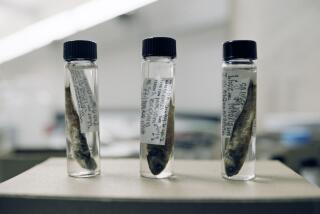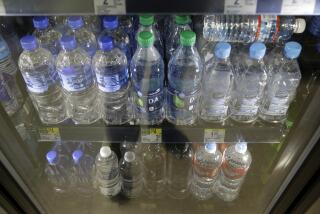The scent of plastic trash makes fish think it’s food, new study finds
- Share via
If you thought “empty calories” were bad for you, consider this: Plastic is ending up in the bellies of fish and other marine life — and it may not be an accident. A new study finds that anchovies were actually attracted to some kinds of plastic, mistaking it for a tasty meal.
The findings, described in the Proceedings of the Royal Society B, shed light on a worrisome reason that so much plastic could be ending up in the ocean’s delicate food web — which includes humans.
As plastic continues to accumulate in our oceans, scientists are looking at the long-term effects that the man-made material might have on the animals that eat it, and on the animals that eat them. But lead author Matthew Savoca, a marine biologist with the National Oceanic and Atmospheric Administration in Monterey, wondered why the animals were eating it at all.
“The aspect of the problem that was most interesting to me was, why are these animals making this mistake in the first place?” Savoca said. After all, fish and other marine life have evolved to target specific kinds of food, which should mean they’d avoid plastic entirely — unless the plastic was somehow “tricking” the animals into thinking it was edible.
“What we really wanted to do was actually think about this problem from the animal’s perspective,” Savoca said.
Some observers have speculated that sea turtles end up munching on plastic bags because they look so much like jellyfish, a regular meal for leatherbacks. But marine creatures often follow their noses rather than their eyes, Savoca said — which might be a counterintuitive concept for humans, who evolved as visual hunters.
Savoca and his colleagues tested different odors on wild schools of anchovies that had been caught off the California coast. They made the smells by soaking different substances in seawater: krill (very tiny crustaceans eaten by anchovies); “biofouled” plastic coated in algae and bacteria (which happens when plastic enters the ocean); and clean plastic.
“You can sort of think of it as steeping tea, or something, and then presenting the tea to the fish,” he said.
Savoca put each flavor of sea-tea into a syringe and injected it into a container holding the swimming anchovies, watching to see how they reacted. (The scientists also used actual krill, in addition to krill-flavored water, in their experiment.)
When the fish sensed the krill-flavored water, they quickly bunched up to focus on the potential food source. They didn’t react that way to the clean plastic, but they did cluster around the biofouled plastic, covered in algae and microbes.
So plastic in the ocean could indeed be attractive to fish because of the algae that live on it. Algae give off a sulfuric smell, Savoca said, and many birds and fish have learned this odor signals a tasty meal.
“It was surprising how obvious and dramatic their responses were,” Savoca said of the experiment.
What happens to fish that eat plastic? And what happens to humans who eat those fish? The effects on marine life of eating plastic aren’t fully known, although researchers have noted certain changes in fish behavior: weakened schooling and a weakened ability to evade predators. It’s possible those responses could be caused by malnutrition, Savoca said, if fish were eating plastic and thinking they were full.
Perhaps scientists could design plastic surfaces to keep algae from clinging to them, Savoca suggested. He added that in the meantime, people can reduce the amount of trash going into the oceans by cutting down on single-use plastics.
Follow @aminawrite on Twitter for more science news and “like” Los Angeles Times Science & Health on Facebook.
MORE IN SCIENCE
The Great American Eclipse: How to watch safely
Will the Great American Eclipse make animals act strangely? Science says yes
Which puppy will be a good guide dog? Ask mom!







